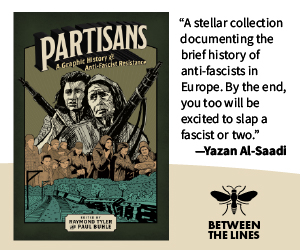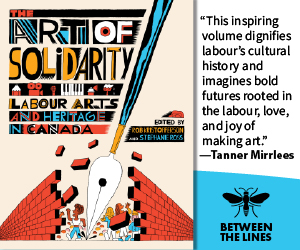-

Something Is Happening in Indian Country
Is the movement for Indigenous rights and self-determination reaching a tipping point in Canada? Recent events give grounds for optimism. This spring in Ontario, the Indian Act chief-and-council from Kitchenuhmaykoosib Inninuwug, grassroots traditionalists from Grassy Narrows and non-status Ardoch Algonquins joined environmentalists, urban radicals, unions and students in an unprecedented coalition to pressure the Ontario government for First Nations’ right to say no to unwanted development on their traditional territories.
-

Like the Sound of a Drum
Peter Kulchyski, Native Studies professor at the University of Manitoba, took up this challenge through many years living in the north, most notably in the communities of Panniqtuuq, in Nunavut, as well as Fort Good Hope and Fort Simpson, in Denendeh (Northwest Territories). The results can be found in his book, Like the Sound of a Drum (University of Manitoba Press, 2001).
-

Tar Sands: Environmental justice, treaty rights and Indigenous peoples
Resources and effort must be placed into building the knowledge and capacity amongst First Nations and Métis leadership, including grassroots, elders and youth, to engage in both an Indigenous-led corporate-finance campaign and in decision-making processes on environment, energy, climate and economic policies related to halting the tar-sands expansion.
-

Drawing a line in the sand
Plans are afoot for the wholesale ecological reconfiguration of vast parts of the northern hemisphere. The planners are suggesting that infrastructure is required to facilitate far-reaching change: the second-largest dam in the world, a possible nuclear-power station at Peace River, and pipelines across Alberta to the west coast, across the prairies, and down the Mackenzie River.
-

Kissing Billie Draper
I fell in love when I was seven. I mean really and truly in love. It was the kind of rapturous love that changes the lighting in your world and makes everything sharper, clearer, like it never existed in quite that way before, or ever will again.
-

The Role of Settlers in Indigenous Struggles
By mid-March, 2006, when activist communities discovered the land reclamation at Six Nations of the Grand River, carloads of non-Aboriginal supporters from Toronto, Montreal and beyond made almost daily trips to the site loaded with supplies and youthful activists eager to staff the cookhouse, help out in the first-aid tent, or do a security shift. At night gaggles of underdressed youth would huddle at the fire, soaking up community gossip directly from “the real grassroots” (as one white activist described members of the Grand River community).
-

One Native Life: Reaching Grandfather
My grandfather’s name was John Wagamese. Our family name, Wagamese, comes from an Ojibway phrase meaning “man walking by the crooked water.” It was shortened by the treaty registrar because Wagamese was all he could pronounce of it, but it came from the trapline my great-great-grandfather established along the Winnipeg River. The same one my grandfather walked all his life.
-

Toward a New Policy Paradigm for First Peoples
The current policy paradigm surrounding Aboriginal issues is locked within a very narrow compass of possibility. The two major ideas that emerged in the last decade were the proposals around the Governance Act, rejected by most First Nations leaders, and the Kelowna Accord, endorsed by the Assembly of First Nations, but dead in the water thanks to the current regime.
-

An Interview with Colleen Cutschall
Colleen Cutschall is a senior artist originally from Pine Ridge, South Dakota. For over twenty years, she has been working and living in Southwest Manitoba as an artist, art historian, educator and curator. Cutschall holds a BFA from Barat College, Lake Forest, Illinois, and a MS.ED from the Black Hills State College, Spearfish, South Dakota. She has had numerous solo exhibitions that include: Voices in the Blood, a touring exhibition organized by the Art Gallery of Southwestern Manitoba, House Made of Stars, The Winnipeg Art Gallery, and …Dies Again, Urban Shaman Gallery. Cutschall has produced numerous publications and lectures on Native issues and art nationally and internationally. She recently partook in an artist – in-residence in Bellagio, Italy. Cutschall is a Professor and Chair of the Visual and Aboriginal Art Department at Brandon University, and continues to work on her artistic practice. This is an excerpt from an interview, where she shares her thoughts on art and art issues in Manitoba.
-
Indigenous Artists Defying Expectations
Since the mid-1960s, contemporary Indigenous artists have faced many challenges their non-Indigenous counterparts have not. From lack of resources, to limited recognition and preconceived notions, they are constantly navigating between artistic practice and cultural expectations. For establishing and established Manitoba artists Kale Bonham, Helen Madelaine, Leah Fontaine, Riel Benn and KC Adams, one recurring obstacle they face are the existing stereotypes about Indigenous artists.




